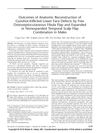Management of High-Energy Avulsive Ballistic Facial Injury: A Review of the Literature and Algorithmic Approach
March 2018
in “
Plastic and Reconstructive Surgery – Global Open
”

TLDR Early surgical treatment for severe facial injuries from high-energy impacts leads to better recovery.
The document summarized the management of high-energy avulsive ballistic facial injuries, highlighting the benefits of early and aggressive surgical intervention. It included a systematic review of 17 articles, with one providing level 3 evidence suggesting that early management leads to better outcomes, such as fewer soft-tissue contractures, fewer total procedures, and shorter hospital stays. The review also noted a geographical difference in management preferences, with delayed reconstruction favored in the Middle East and immediate or early reconstruction favored in the United States. The document emphasized the lack of studies comparing debridement timing or flap selection based on defect characteristics. Despite the limited evidence, an algorithm for a 3-stage reconstructive approach was proposed, advocating for early and definitive reconstruction using aesthetic free tissue transfer. The document also discussed the importance of CT scans and CSP for planning, the use of free tissue transfer and bone grafting, and the need for secondary revisions, including hair micrografting. Case reports demonstrated the advantages of early definitive reconstruction in maintaining facial proportions. The conclusion called for more comparative studies to confirm the proposed benefits of early intervention.




